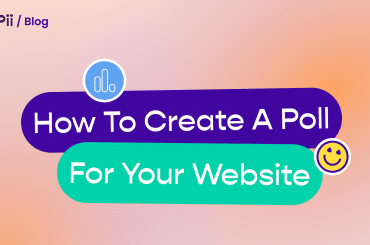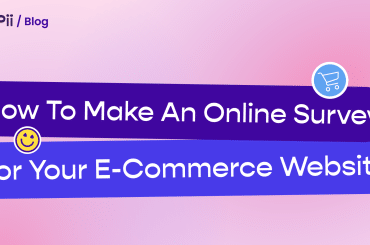Listen to your customers, this has to be one of the most common pieces of advice that marketers love to give.
I mean at this point it became a cliche, but that doesn’t mean it’s not effective.
Some of the most repeated cliche things that get said on marketing are actually good advice, that’s why they’ve been repeated so much.
Poor execution on the other hand made it cliche, which is unfortunate, but what if you want to listen to your customer, what should you do?
Well, surveys are a great way to do that, they’re easy to use, effective, and can be very informative.
I launched a survey on our home page to know “What brought my visitors to my website”, and one of the answers lit a light bulb in my head on what should I be doing next.
He sent “I’m looking for an alternative to HotJar because they changed the pricing model and it doesn’t make sense for a small website like mine.”
That led to an internal meeting, which led to a new experiment that we’re running now to see what performs the best!
A simple survey answer gave us a new positioning opportunity to test, without having to use any internal resources planning it.
But when it comes to surveys, there are different types, some will help you know how satisfied are your customers with your product.
Some will help you understand the level of loyalty that your customers have to your brand.
And that raises the question, which one should you use? In this blog post, we will talk about 5 surveys that any business can utilize to achieve its goals.
NPS (Net Promoter Score) Surveys
NPS or Net Promoter Score survey is a type of survey that’s designed to measure the overall satisfaction of a customer with a company or a product.
It’s used widely by customer success and customer experience teams to get a feel for the experience that their customers had with them.
NPS is used as a long-term measure of brand loyalty and happiness of the experience given so far.
It ranges from 1 to 10, 1 being the lowest rating while 10 being the highest rating.
Why should you use NPS Surveys?
NPS surveys can help you understand which areas of your products need improvement.
They can also help you know how likely your customers are to recommend your company, measure customers’ loyalty and identify different customer segments.
NPS surveys give you the bigger picture of your business, if you see something isn’t right you can always drill deeper.
Example of NPS (Net Promoter Score) Questions
The main question for the NPS survey is:
On a scale from 0-10, how likely are you to recommend [product X] to a friend or colleague?
Not at all: 0, 1, 2, 3, 4, 5, 6, 7, 8, 9, Extremely: 10
But is an NPS survey enough? It depends on what you’re trying to achieve.
If you’re looking to gather quantitative data, then the NPS survey is more than enough to achieve your goal.
But if you want to collect qualitative data then you can follow up with questions like:
- What are the primary reasons for the score you gave [product X]?
- Would it be okay for us to follow up with you about your responses?
If they agree follow it up with “what’s the best email address to reach you?” to quickly capitalize on the momentum and avoid them losing interest.
Then drill deeper into why did they answer like that, do a quick meeting or get them on an interview that you can use later on to craft your product and messaging in the future.
How to Calculate NPS?
As it stands there are three types of customers:
- Detractors: unhappy customers (Score: 0-6).
- Passives: satisfied but unenthusiastic customers (Score: 7-8).
- Promoters: loyal, enthusiastic customers (Score: 9-10).
To calculate the NP score, you need to subtract the percentage of detractors from the percentage of promoters.
For example, when you launch your survey and find out that 30% of respondents are detractors, 10% are passives, and 60% are promoters, then your NPS score would be 60-30 = 30.
CSAT (Customer Satisfaction) Surveys For E-commerce & SaaS
CSAT stands for customer satisfaction score. It’s usually used as a key performance indicator for customer success teams in companies and stores.
CSAT determines the level of satisfaction, but unlike the NPS, it is only used in certain situations because it offers a highly focused quantitative answer.
CSAT is usually thought of as a short-term measure of customer satisfaction with the experience he just had with a product or a service.
It’s used to improve the user experience, for instance, when customers are using your product, and you want to check if they are facing any issues so you can fix them.
In this survey, you give customers options on scales from 1 to 5. For example:
- Very unsatisfied (1)
- Unsatisfied (2)
- Neutral (3)
- Satisfied (4)
- Very satisfied (5)
As you can see it gives the customer fewer options to choose from unlike NPS because in this case, we’re trying to determine if the experience that the customer had was satisfying or not.
Why Should You Use CSAT Surveys?
CSAT surveys can help you understand if you’re providing the best experience for your customers or not.
They can help with growing your brand by building a world-class experience on your website or app leading to more customers sticking with your brand.
CSAT is usually used as a KPI so it’s really useful whenever you’re trying to know where is the weakest link in your customer’s experience.
Examples of CSAT (Customer Satisfaction) Questions For E-commerce
How satisfied are you with [product X]?
- When to ask: after 2 weeks of purchase
- Where: email.
How satisfied are you with buying from us?
- When to ask: Right after purchase
- Where: order confirmation.
How likely are you to purchase again from our store?
- When to ask: A day after purchase
- Where: order confirmation or email.
Examples of CSAT (Customer Satisfaction) Questions For SaaS
On a scale of 1 to 10, how satisfied are you with your onboarding experience?
- When to ask: after completing the onboarding process
- Where: website/dashboard.
How satisfied are you with our new product?
- When to ask: after 2 weeks of releasing a new product
- Where: website/dashboard.
Product-Market Fit Surveys
A product-market fit survey is a survey that helps businesses determine how their product do when launched.
It’s used to help businesses know if their product has enough demand in the market so that when it launches it won’t fail immediately.
PMF Surveys are used a lot in early-stage products and companies.
This kind of survey consists of only one question that tests if you have proven your hypothesis or not – about why a user should choose your product.
Examples of Product-Market Fit Surveys
The main question for product-market fit surveys is:
How would you feel if you could no longer use [product X]?
- Very disappointed
- Somewhat disappointed
- Not disappointed
- I no longer use it
Source: Delighted
Why Should You Use PMF Surveys?
You need to use a product-market fit survey when you’ve recently launched a new product or a service and given customers some time to try it out.
You should use a PMF survey to see how your customers would react to the question of your product not existing anymore.
Their answer should be considered as a KPI of your product, if a lot of customers say they’d be very disappointed that means you have a strong product on hand.
But if they say well, I wouldn’t care that much then you’ve got a real problem on your hand because your product isn’t providing value or worst easily replaceable.
Churn Reasons Surveys
Churn reasons surveys are surveys that help you understand why is your customer canceling their subscription or why are they leaving you.
They are widely used by SaaS companies and other subscription-based businesses to know the reason behind their customer’s churn.
Examples of Churn Reasons Surveys
There are three kinds of questions you can ask within a churn survey:
Multiple-choice questions
What’s the main reason you are canceling your account?
- I am not using it anymore
- The price is too high
- It was not effective, and I didn’t see the results I expected
- Your product doesn’t have the features I need
- I only needed it for a short-term project
Open-ended questions
- Before you go, please tell us the reason you’re leaving.
Mixed questions are a mix of the previous two types. It consists of a response box (optional) under the multiple-choice question.
Source: BareMetrics
Product Roadmap Surveys
A product roadmap is a plan that provides guidance on how to develop your products, and that’s why product roadmap surveys are very important.
They’re widely used in companies with a tech product that they work on developing, like SaaS companies.
Examples of Product Roadmap Survey Questions
- Which features or product changes would you like to see the most?
- How interested would you be in trying [feature X]?
- Which integration would you like us to build next?
- Please rank the following features in terms of importance to you – (1 is least important and 5 is most important)
– Feature 1
– Feature 2
– Feature 3
– Feature 4
– Feature 5
- When to ask: when you want to prioritize a new feature or upgrade an existing one based on customers’ needs and preferences.
- Where: email
CES (Customer Effort Score) Surveys
CES surveys or customer effort score surveys help businesses how easy their customer find their products and services to use.
As a company, you need to make your products easy to use if you’re looking for high acquisition rates, and that’s where CES Surveys come in crucial.
Customer Effort Score formula
The Customer Effort Score formula helps you determine the percentage of positive and negative responses to the survey.
You can calculate it by subtracting the negative responses (very difficult and difficult) from the positive responses (very easy and easy).
Examples of CES (Customer Effort Score) Surveys
- How easy was it for you to find the product(s) you were looking for in our store?
Very easy – Easy – Neither – Difficult – Very difficult
Conclusion
Surveys are a fantastic way to gather the information that helps your business do better.
But depending on what info you’re looking for you’ll need a different survey, and so we’ve talked in this blog about 5 of the most important surveys that you can utilize now.
But the question to you is, what survey do you use the most in your day-to-day business?



